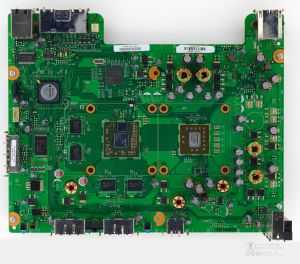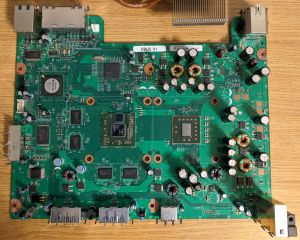Falcon: Difference between revisions
Jump to navigation
Jump to search
No edit summary |
|||
| (52 intermediate revisions by the same user not shown) | |||
| Line 1: | Line 1: | ||
{{Infobox | {{Infobox Motherboard | ||
| name = Falcon | | name = Falcon | ||
| image = X812320-003.jpg | |||
| introduced = Late 2007 | | introduced = Late 2007 | ||
| partnumber = X812320 | | partnumber = X812320 | ||
| usedin = [[Xbox 360 (Original)]] | | usedin = [[Xbox 360 (Original)]] | ||
| cputype = [[ | | cputype = [[Loki]] | ||
| gputype = [[ | | gputype = [[Rhea]] | ||
| cpuprocess = 65nm | | cpuprocess = 65nm | ||
| gpuprocess = | | gpuprocess = 90nm | ||
| edramprocess = | | edramprocess = 90nm | ||
| nandsize = 16MB | | nandsize = 16MB (Retail)<br>64MB (Dev) | ||
| video = [[A/V | | video = [[A/V]] and HDMI | ||
| wattage = 175W | | wattage = 175W | ||
| 12vamps = 14.2A | | 12vamps = 14.2A | ||
| predecessor = [[ | | predecessor = [[Zephyr_C]] | ||
| successor = [[Jasper]] | | successor = [[Jasper]] | ||
}} | }} | ||
'''Falcon''' is the successor to the [[Zephyr_C]] [[motherboard]] and is used in the [[Original Xbox 360]] series. | |||
=== Notable Differences === | === Notable Differences === | ||
* The | * The [[Waternoose]] CPU has been replaced with the [[Loki]] CPU | ||
* When the revised GPUs | * Around March 2008, fixed GPUs started being used in some units, but was not universally used until roughly June/July 2008 | ||
* | * When the revised GPUs started rolling out, almost all boards started using [[Qimonda RAM#HYB18H1G321AF-14|Qimonda HYB18H1G321AF-14]] RAM in a 4x128MB config | ||
* The | * [[Qimonda RAM#HYB18H512322AF-13|Qimonda HYB18H51232'''2A'''F-1'''3''']] RAM has been replaced with [[Qimonda RAM#HYB18H512321BF-14|Qimonda HYB18H51232'''1B'''F-1'''4''']] | ||
* The board layout has been modified to support the | * When the revised GPUs rolled out, [[Hynix RAM#HY5RS123235BFP-14|Hynix HY5RS123235BFP-14]] and [[Qimonda RAM#HYB18H512321BF-13|Qimonda HYB18H512321BF-13]] RAM are no longer used | ||
* The [[Power Rails (Original)#V_CPUCORE|V_CPUCORE]] voltage regulation is now 2 phases, down from 3 phases, but the pads and silkscreen for the third phase still remain | |||
* The | * The [[Power Rails (Original)#V_CPUVCS|V_CPUVCS]] rail was added for the Loki CPU, as VCS is no longer on silicon | ||
* Some later boards | * The board layout has been modified to support the Loki CPU | ||
* The [[ | * The J7G3 [[Titan]] connector on the front of the motherboard was left on the final motherboard | ||
* Some later boards use solid state capacitors for the CPU and GPU output filters | |||
* The [[Heatsink#Heatpipe CPU|heatpipe]] CPU heatsink was replaced with the [[Heatsink#Aluminum CPU| aluminum]] CPU heatsink, however some early systems did not have this change | |||
=== Specifications === | === Specifications === | ||
* 65nm | * 65nm [[Loki]] CPU | ||
* | * 90nm [[Rhea]] GPU/eDRAM | ||
* 512MB | * 512MB GDDR3 RAM | ||
** 8x64MB [[Hynix RAM# | ** 8x64MB [[Hynix RAM#HY5RS123235BFP-14|Hynix HY5RS123235BFP-14]] (Early Boards) | ||
** 8x64MB [[Qimonda RAM# | ** 8x64MB [[Qimonda RAM#HYB18H512321BF-14|Qimonda HYB18H512321BF-14]] (Early Boards) | ||
** 4x128MB [[Qimonda RAM#HYB18H1G321AF-14|Qimonda HYB18H1G321AF-14]] (Mid/Late | ** 4x128MB [[Qimonda RAM#HYB18H1G321AF-14|Qimonda HYB18H1G321AF-14]] (Mid/Late Boards) | ||
* [[XSB]] Southbridge | * [[XSB#R0|XSB R0]] Southbridge | ||
* [[HANA]] | * [[HANA]] | ||
* 16MB [[Nand#Hynix HY27US08281A|Hynix HY27US08281A]] Nand | * Nand | ||
* Boardcom or ICS Ethernet PHY | ** 16MB [[Nand#Hynix HY27US08281A|Hynix HY27US08281A]] ([[Retail|Retail]]) | ||
** 64MB [[Nand#Samsung K9F1208U0B|Samsung K9F1208U0B]] ([[Developer Hardware|Dev]]) | |||
* Boardcom or ICS [[Ethernet PHY]] | |||
* [[Heatsink#Aluminum CPU|Aluminum]] CPU Heatsink | |||
** [[Heatsink#Heatpipe CPU|Heatpipe]] CPU Heatsink used on early units | |||
* [[Heatsink#Extended GPU|Extended]] GPU Heatsink | |||
== Opus == | == Opus == | ||
The '''Opus''' | [[File:X812320-003-Opus.jpg|thumb|300px|upright|right|Falcon that has been converted to an Opus]] | ||
The '''Opus''' name describes a project of fitting a Falcon board into the casings for a Xenon. This was done with a custom A/V port and the removal of the HDMI port. Opus was used for refurbishing defective consoles until the [[Elpis (Motherboard)|Elpis]] boards started being produced. | |||
=== Notable Differences === | === Notable Differences === | ||
* Removal of the HDMI port | * Removal of the HDMI port | ||
* Custom A/V port to fit the HDMI board layout while being able to fit into the Xenon casing | * Custom A/V port to fit the HDMI board layout while being able to fit into the Xenon casing | ||
* All Opus | * All Opus boards use revised versions of the [[Rhea]] GPU with higher Tg underfill | ||
{{Console Components}} | |||
[[Category:Motherboards]] | [[Category:Motherboards]] | ||
Latest revision as of 12:32, 29 August 2024
 | |
| Part Number | X812320 |
|---|---|
| Introduced | Late 2007 |
| Used In | Xbox 360 (Original) |
| CPU Type | Loki |
| GPU Type | Rhea |
| CPU Process | 65nm |
| GPU Process | 90nm |
| eDRAM Process | 90nm |
| Nand Size | 16MB (Retail) 64MB (Dev) |
| Video Outputs | A/V and HDMI |
| Wattage | 175W |
| 12V Amperage | 14.2A |
| Predecessor | Zephyr_C |
| Successor | Jasper |
Falcon is the successor to the Zephyr_C motherboard and is used in the Original Xbox 360 series.
Notable Differences
- The Waternoose CPU has been replaced with the Loki CPU
- Around March 2008, fixed GPUs started being used in some units, but was not universally used until roughly June/July 2008
- When the revised GPUs started rolling out, almost all boards started using Qimonda HYB18H1G321AF-14 RAM in a 4x128MB config
- Qimonda HYB18H512322AF-13 RAM has been replaced with Qimonda HYB18H512321BF-14
- When the revised GPUs rolled out, Hynix HY5RS123235BFP-14 and Qimonda HYB18H512321BF-13 RAM are no longer used
- The V_CPUCORE voltage regulation is now 2 phases, down from 3 phases, but the pads and silkscreen for the third phase still remain
- The V_CPUVCS rail was added for the Loki CPU, as VCS is no longer on silicon
- The board layout has been modified to support the Loki CPU
- The J7G3 Titan connector on the front of the motherboard was left on the final motherboard
- Some later boards use solid state capacitors for the CPU and GPU output filters
- The heatpipe CPU heatsink was replaced with the aluminum CPU heatsink, however some early systems did not have this change
Specifications
- 65nm Loki CPU
- 90nm Rhea GPU/eDRAM
- 512MB GDDR3 RAM
- 8x64MB Hynix HY5RS123235BFP-14 (Early Boards)
- 8x64MB Qimonda HYB18H512321BF-14 (Early Boards)
- 4x128MB Qimonda HYB18H1G321AF-14 (Mid/Late Boards)
- XSB R0 Southbridge
- HANA
- Nand
- 16MB Hynix HY27US08281A (Retail)
- 64MB Samsung K9F1208U0B (Dev)
- Boardcom or ICS Ethernet PHY
- Aluminum CPU Heatsink
- Heatpipe CPU Heatsink used on early units
- Extended GPU Heatsink
Opus
The Opus name describes a project of fitting a Falcon board into the casings for a Xenon. This was done with a custom A/V port and the removal of the HDMI port. Opus was used for refurbishing defective consoles until the Elpis boards started being produced.
Notable Differences
- Removal of the HDMI port
- Custom A/V port to fit the HDMI board layout while being able to fit into the Xenon casing
- All Opus boards use revised versions of the Rhea GPU with higher Tg underfill
